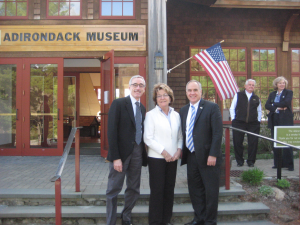
After a visit to Old Forge, Tom WIlliams, President of the Adirondack Landowners Association, who arranged for Comptroller DiNapoli's cisit, escorted the comptroller to Blue Mountain Lake. DiNapoli, right, is shown her with David kahn, Executive Director of the Adirondack Museum, and NYS Senator Betty Little. Courtesy Photo
New York State Comptroller Thomas DiNapoli paid a visit to the Central Adirondacks on Friday, May 11 at the request of the Adirondack Landowners Association’s President, Tom Williams.
The visit, Williams said, was the result of a year long effort between the ALA and the Comptroller’s office to educate elected and appointed officials in Albany, as well as the general public, about the unique contributions private land owners make and to help them understand the potential environmental detriment of future legislative decisions.
In 2011, the Comptroller’s Office first met with the ALA for a presentation on an ALA initiative regarding the spread of invasive species.
“Our presentation was simple,” Williams said, “ It’s a lot cheaper to prevent it than it is to clean it up afterwards.”
The initiative at this meeting, however, focused on the relationship that private landowners and organizations such as the ALA have with the Adirondacks on economic, environmental, and emotional levels and what happens when these partnerships begin to disappear.“The reason that private stewardship works in the Adirondacks with the landowners is because they have skin in the game,” Williams said.
“They’ve made an investment. This is a generational legacy that takes place, one that is carried on from one family and one situation. Father to son, to daughter and so forth and that’s the reason it works.”
DiNapoli’s time in Old Forge began with a quick tour of the Adirondack League Club (ALC), followed by a luncheon in the dining room.
During the luncheon, DiNapoli had the opportunity to talk with representatives from the ALA and the League Club, APA Chair-woman Lani Ulrich, and Dan Josephson and Cliff Crafts of the Cornell University’s Fish Hatchery Research Program.
Among the topics of discussion were issues regarding aging in a rural area, stewardship of the land, taxes, and the best way to ensure economic vitality throughout the Adirondacks.
“The issues here are, in some ways, no different than in other parts of our state. But you have a very unique dynamic here, so it does play out a little differently,” DiNapoli said.
The challenge, he said, is to determine the best way to ensure the economic vitality and sustainability of this part of the state, while at the same time preserve the natural legacy.
“Those of us in government—whether it is state government or local government—those that are land owners, including large land owners, and those who are involved in a great community like the League Club. Those who are perhaps the town folks who have been here a long time, those who are the occasional visitors, those who identify themselves as environmentalists-whatever the label,” he said, “we need to figure out how everyone can come together, meet in the appropriate common ground and say, ‘We have a shared interest in preserving what’s wonderful about the Adirondacks while also figuring out how we need to move forward.’ Nothing stays the same, right? We have to recognize the challenges,” DiNapoli said.
Following the luncheon, DiNapoli was taken to the Little Moose Field Station, which is part of the Adirondack Fishery Research Program at Cornell University.
While there, Field Station manager Dan Josephson and Cliff Kraft, associate professor of the Department of Natural Resources at Cornell, gave DiNapoli a rundown of the research done and data collected through the 60-year private-public partnership.
Cornell’s Adirondack fisheries research efforts are conducted in collaboration with partners from other academic institutions, state and federal agencies, and private stakeholders who share the common goal of sustaining a research program that addresses important aquatic resource management issues in northern lakes and streams that will result in a wild self-sustained fish population throughout New York state.
“The trout that get stocked in New York by the DEC are a hybrid brook trout whose science was developed here,” Williams said.
“The average sportsman, the guy who buys the license, who buys the container of worms to go fishing here; has no idea that the fisheries are a result of this public-private partnership that’s been going on for fifty to sixty years, and is benefiting the public. They don’t really know about it, but if anything happens to those relationships, they’ll be asking what happened to the fish,” he added.
Following the presentation at the fish hatchery, DiNapoli was taken to View for a tour which was led by Executive Director Jennifer Potter Hayes.
DiNapoli then addressed a group of local government and business leaders to outline what the responsibilities of his office are, and ways in which they go about analyzing what is happening throughout the state and the impact that has on the state budget and local economies.
Following his trip to View, DiNapoli traveled to Blue Mountain Lake for a tour of the Adirondack Museum.
He wrapped up his visit at an ALA dinner at Minnowbrook Resort where he was the guest of honor.
“It was certainly a high watermark weekend for the Adirondack Landowners Association. I think it will set the stage for things that we do over the summer and into the fall and building up to our winter meeting,” Williams said.
